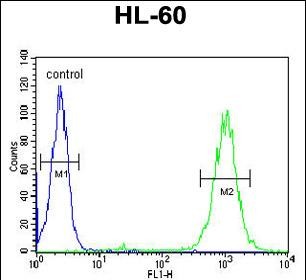BLM Antibody (C-term)
Affinity Purified Rabbit Polyclonal Antibody (Pab)
- SPECIFICATION
- CITATIONS
- PROTOCOLS
- BACKGROUND

Application
| FC, WB, E |
|---|---|
| Primary Accession | P54132 |
| Reactivity | Human |
| Host | Rabbit |
| Clonality | Polyclonal |
| Isotype | Rabbit IgG |
| Calculated MW | 159000 Da |
| Antigen Region | 1054-1082 aa |
| Gene ID | 641 |
|---|---|
| Other Names | Bloom syndrome protein, DNA helicase, RecQ-like type 2, RecQ2, RecQ protein-like 3, BLM, RECQ2, RECQL3 |
| Target/Specificity | This BLM antibody is generated from rabbits immunized with a KLH conjugated synthetic peptide between 1054-1082 amino acids from the C-terminal region of human BLM. |
| Dilution | FC~~1:10~50 WB~~1:1000 E~~Use at an assay dependent concentration. |
| Format | Purified polyclonal antibody supplied in PBS with 0.09% (W/V) sodium azide. This antibody is purified through a protein A column, followed by peptide affinity purification. |
| Storage | Maintain refrigerated at 2-8°C for up to 2 weeks. For long term storage store at -20°C in small aliquots to prevent freeze-thaw cycles. |
| Precautions | BLM Antibody (C-term) is for research use only and not for use in diagnostic or therapeutic procedures. |
| Name | BLM |
|---|---|
| Synonyms | RECQ2, RECQL3 |
| Function | ATP-dependent DNA helicase that unwinds double-stranded (ds)DNA in a 3'-5' direction (PubMed:24816114, PubMed:25901030, PubMed:9388193, PubMed:9765292). Participates in DNA replication and repair (PubMed:12019152, PubMed:21325134, PubMed:23509288, PubMed:34606619). Involved in 5'-end resection of DNA during double- strand break (DSB) repair: unwinds DNA and recruits DNA2 which mediates the cleavage of 5'-ssDNA (PubMed:21325134). Stimulates DNA 4-way junction branch migration and DNA Holliday junction dissolution (PubMed:25901030). Binds single-stranded DNA (ssDNA), forked duplex DNA and Holliday junction DNA (PubMed:20639533, PubMed:24257077, PubMed:25901030). Unwinds G-quadruplex DNA; unwinding occurs in the 3'- 5' direction and requires a 3' single-stranded end of at least 7 nucleotides (PubMed:18426915, PubMed:9765292). Helicase activity is higher on G-quadruplex substrates than on duplex DNA substrates (PubMed:9765292). Telomeres, immunoglobulin heavy chain switch regions and rDNA are notably G-rich; formation of G-quadruplex DNA would block DNA replication and transcription (PubMed:18426915, PubMed:9765292). Negatively regulates sister chromatid exchange (SCE) (PubMed:25901030). Recruited by the KHDC3L-OOEP scaffold to DNA replication forks where it is retained by TRIM25 ubiquitination, it thereby promotes the restart of stalled replication forks (By similarity). |
| Cellular Location | Nucleus. Note=Together with SPIDR, is redistributed in discrete nuclear DNA damage-induced foci following hydroxyurea (HU) or camptothecin (CPT) treatment. Accumulated at sites of DNA damage in a RMI complex- and SPIDR-dependent manner |

Thousands of laboratories across the world have published research that depended on the performance of antibodies from Abcepta to advance their research. Check out links to articles that cite our products in major peer-reviewed journals, organized by research category.
info@abcepta.com, and receive a free "I Love Antibodies" mug.
Provided below are standard protocols that you may find useful for product applications.
Background
BLM is related to the RecQ subset of DExH box-containing DNA helicases and has both DNA-stimulated ATPase and ATP-dependent DNA helicase activities.
References
Davila, S., et al. Genes Immun. 11(3):232-238(2010)
Frank, B., et al. Carcinogenesis 31(3):442-445(2010)
Ouyang, K.J., et al. PLoS Biol. 7 (12), E1000252 (2009)
If you have used an Abcepta product and would like to share how it has performed, please click on the "Submit Review" button and provide the requested information. Our staff will examine and post your review and contact you if needed.
If you have any additional inquiries please email technical services at tech@abcepta.com.














 Foundational characteristics of cancer include proliferation, angiogenesis, migration, evasion of apoptosis, and cellular immortality. Find key markers for these cellular processes and antibodies to detect them.
Foundational characteristics of cancer include proliferation, angiogenesis, migration, evasion of apoptosis, and cellular immortality. Find key markers for these cellular processes and antibodies to detect them. The SUMOplot™ Analysis Program predicts and scores sumoylation sites in your protein. SUMOylation is a post-translational modification involved in various cellular processes, such as nuclear-cytosolic transport, transcriptional regulation, apoptosis, protein stability, response to stress, and progression through the cell cycle.
The SUMOplot™ Analysis Program predicts and scores sumoylation sites in your protein. SUMOylation is a post-translational modification involved in various cellular processes, such as nuclear-cytosolic transport, transcriptional regulation, apoptosis, protein stability, response to stress, and progression through the cell cycle. The Autophagy Receptor Motif Plotter predicts and scores autophagy receptor binding sites in your protein. Identifying proteins connected to this pathway is critical to understanding the role of autophagy in physiological as well as pathological processes such as development, differentiation, neurodegenerative diseases, stress, infection, and cancer.
The Autophagy Receptor Motif Plotter predicts and scores autophagy receptor binding sites in your protein. Identifying proteins connected to this pathway is critical to understanding the role of autophagy in physiological as well as pathological processes such as development, differentiation, neurodegenerative diseases, stress, infection, and cancer.



